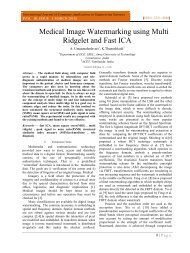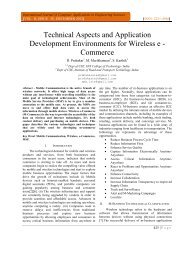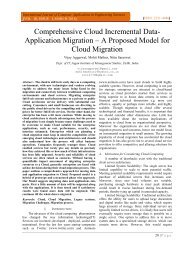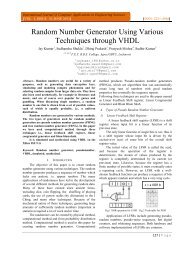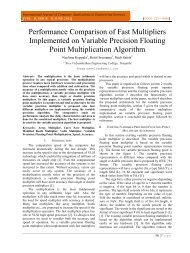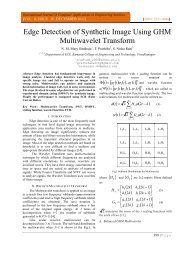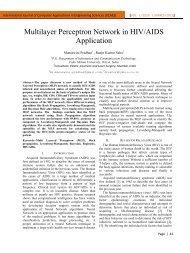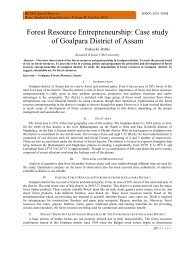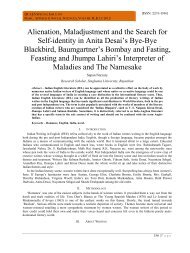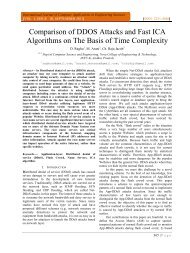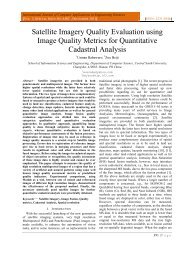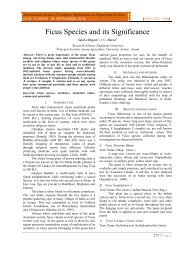IEEE Paper Template in A4 (V1) - International Journal of Computer ...
IEEE Paper Template in A4 (V1) - International Journal of Computer ...
IEEE Paper Template in A4 (V1) - International Journal of Computer ...
You also want an ePaper? Increase the reach of your titles
YUMPU automatically turns print PDFs into web optimized ePapers that Google loves.
Gupta et. al.<br />
exclude new device implementation concepts based on<br />
their potential application <strong>in</strong> these larger circuits. Us<strong>in</strong>g<br />
simulations we have, for example, identified a<br />
fundamental requirement for multilayer capability <strong>in</strong><br />
complex circuits, previously believe unnecessary [12].<br />
The physical <strong>in</strong>teractions between cells may be used<br />
to realize elementary Boolean logic functions. The basic<br />
logic gates <strong>in</strong> QCA are the Majority logic function and<br />
the Inverter which are illustrated <strong>in</strong> Fig. 2. The Majority<br />
logic function can be realized by only 5 QCA cells. The<br />
logic AND function can be implemented from a<br />
Majority logic function by sett<strong>in</strong>g one <strong>in</strong>put<br />
permanently to 0 and the logic OR function can be<br />
Implemented from a Majority logic function by sett<strong>in</strong>g<br />
one <strong>in</strong>put permanently to 1.<br />
Input<br />
Input2<br />
(a) QCA Inverter<br />
(b) QCA Majority Voter<br />
Fig 2: QCA Logic Gates<br />
II. QCA CLOCKING AND DEVICE LEVEL LATCHING<br />
Unlike the transistor, a basic QCA cell has no<br />
<strong>in</strong>herent directionality for <strong>in</strong>formation flow, and a<br />
circuit made <strong>of</strong> un-clocked cells would propagate<br />
<strong>in</strong>formation <strong>in</strong> uncontrollable directions. In order to<br />
control the flow <strong>of</strong> <strong>in</strong>formation <strong>in</strong> a QCA circuit, four<br />
clock signals, each shifted <strong>in</strong> phase by 90o, as shown <strong>in</strong><br />
Figure 3, are used [13,14]. These clock signals are<br />
expected to be generated by a support<strong>in</strong>g technology<br />
such as a CMOS circuit which is used to control the<br />
tunnel<strong>in</strong>g ability <strong>of</strong> electrons with<strong>in</strong> the cell.<br />
Clock Zone 0<br />
Clock Zone 1<br />
Clock Zone 2<br />
Clock Zone 3<br />
1 0<br />
1<br />
0<br />
0<br />
Input1<br />
Input3<br />
Fig 3: QCA Clock<strong>in</strong>g Zones<br />
0<br />
Output<br />
Output<br />
The clock signals act to pump <strong>in</strong>formation <strong>in</strong><br />
controlled directions <strong>in</strong> the circuit as a result <strong>of</strong> the<br />
successive latch<strong>in</strong>g and unlatch<strong>in</strong>g <strong>in</strong> cells connected to<br />
different clock phases. For example, a wire, which is<br />
clocked from left to right with <strong>in</strong>creas<strong>in</strong>g clock<strong>in</strong>g<br />
zones, will carry <strong>in</strong>formation <strong>in</strong> the same direction; i.e.,<br />
from left to right. This acts to pipel<strong>in</strong>e QCA circuits at a<br />
device level. QCA wires allow more than one bit <strong>of</strong><br />
<strong>in</strong>formation to be propagated along the same wire at any<br />
one time. When the clock drops it latches the cells <strong>in</strong>to<br />
one <strong>of</strong> two possible polarizations based on the <strong>in</strong>fluence<br />
<strong>of</strong> all its neighbor<strong>in</strong>g cells. When the clock signal is<br />
high, the cells are relaxed, and have no polarization. The<br />
m<strong>in</strong>imum size <strong>of</strong> the clock<strong>in</strong>g zone is determ<strong>in</strong>ed by the<br />
m<strong>in</strong>imum feature size <strong>of</strong> the technology used to support<br />
clock<strong>in</strong>g. Large clock<strong>in</strong>g zones can be problematic<br />
because signals travel<strong>in</strong>g down long QCA wires have<br />
<strong>in</strong>creased probability <strong>of</strong> error from outside <strong>in</strong>fluences.<br />
These <strong>in</strong>clude thermal effects, which can potentially flip<br />
the state <strong>of</strong> a cell. Small clock<strong>in</strong>g zones allow the<br />
designer the ability to create more complicated and<br />
dense circuits. They also decrease the probability <strong>of</strong><br />
error <strong>in</strong> the circuit. However, smaller clock<strong>in</strong>g zones are<br />
generally more difficult to fabricate.<br />
III. QCA INFORMATION FLOW<br />
Switch<strong>in</strong>g is driven by perturbations <strong>in</strong>troduced by<br />
outside <strong>in</strong>fluences, such as neighbor<strong>in</strong>g cells, which<br />
cause the cell to switch from one polarization to another<br />
as illustrated <strong>in</strong> Fig. 4. This <strong>in</strong>volves the transfer <strong>of</strong><br />
electrons between the sites <strong>of</strong> the cell, which is made<br />
possible due to quantum mechanical tunnel<strong>in</strong>g.<br />
Quantum tunnel<strong>in</strong>g enables particles to be transmitted<br />
through potential barriers without hav<strong>in</strong>g the required<br />
energy to overcome the barrier. The design <strong>of</strong> QCA<br />
circuits <strong>in</strong>volves f<strong>in</strong>d<strong>in</strong>g a layout <strong>of</strong> cells, where the<br />
ground state <strong>of</strong> the layout for a particular set <strong>of</strong><br />
boundary conditions provided by the <strong>in</strong>puts is the<br />
solution to the designed logical function. By provid<strong>in</strong>g a<br />
suitable environment, the cell will relax to the ground<br />
state. Changes <strong>in</strong> the boundary conditions (<strong>in</strong>put values)<br />
cause the system to relax to a new ground state, and a<br />
new output. Unfortunately, comput<strong>in</strong>g with the ground<br />
state implies that the system is sensitive to temperature<br />
effects. In order for the system to be thermodynamically<br />
robust, the k<strong>in</strong>k energy, E k<strong>in</strong>k , and other relevant<br />
energies must be larger than the thermal ambient energy<br />
K B T.<br />
Input<br />
ClockZone0ClockZone1ClockZone2ClockZone3<br />
Fig 4: QCA Wire<br />
IV. ARCHITECTURE OF ALU<br />
Output<br />
282 | P a g e



